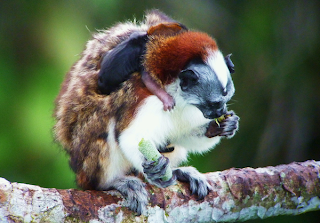True Wild Life | Geoffroy's Tamarin | The Geoffroy's tamarin is a small species of monkey found in the forests of South America. The Geoffroy's tamarin is also known as the Red-crested tamarin or the Rufous-naped tamarin, and is thought to be closely related to the cottontop tamarin. The Geoffroy's tamarin is found in the tropical forests of Panama and Colombia in South America, where the Geoffroy's tamarin spends the majority of it's life in the trees. The Geoffroy's tamarin is more commonly found on the Pacific coast rather than the Atlantic.
The Geoffroy's tamarin has has a very distinctive "v" shape mark on it's head and has no fur on it's face. The Geoffroy's tamarin is highly territorial and is known to make numerous different calls and threats to approaching danger in the surrounding forest. The Geoffroy's tamarin is a diurnal primate which means that the Geoffroy's tamarin is most active during the day and rests in the safety of the tree tops during the night. Geoffroy's tamarins are very sociable animals and inhabit their territory with their rest of the Geoffroy's tamarin troop which generally have between 3 and 9 members. Geoffroy's tamarin troops are led by the eldest female and have predominantly male members.
The Geoffroy's tamarin is an omnivorous animal meaning that the Geoffroy's tamarin hunts both plants and other animals in order to survive. Fruits, insects and green plants make up the majority of the Geoffroy's tamarin's diet along with small rodents and reptiles, eggs and tree sap. Due to the relatively small size of the Geoffroy's tamarin, it has a number of predators within it's natural environment. Wild cats, dogs, snakes and birds of prey are primary predators of the Geoffroy's tamarin, along with humans who are destroying their natural habitat.
The Geoffroy's tamarin usually breeds between the months of April and July, when the female Geoffroy's tamarin will give birth to twins (or a single infant) after a four to five month gestation period. The male Geoffroy's tamarin's carry and groom infants more than the females do, but females clean the infant more than the males do. Older siblings are also known to contribute to infant care, although infants prefer to be carried by their parents than by their siblings. Infant Geoffroy's tamarins become mobile at 2 to 5 weeks, and begin eating solid food at 4 to 7 weeks. They are independent at 10 to 18 weeks and are fully weaned at 15 to 25 weeks. Sexual maturity is attained at about 2 years of age.
Today, the Geoffroy's tamarin is not considered to be a species that is in danger of becoming extinct, although the Geoffroy's tamarin population in the wild of South America has been declining in recent years primarily due to habitat loss.





No comments:
Post a Comment